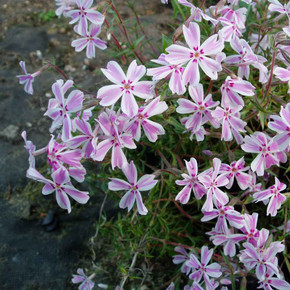
Phlox subulata 'Eye Candy' - CREEPING PHLOX 'EYE CANDY'
Cultivar with light lavender-pink flowers with dark wine purple eye. Vigorous, but stays in mounds and doesn't spread like some other cultivars.
4" tall x 20" wide
Moss phlox or creeping phlox forms dense low evergreen or semi-evergreen mats. In early spring, the flowers completely cover the whole plants.
Easy to grow perennial, the only need is some sunlight and drainage. Favorite rock garden plan, or edging plant, for dry slopes, as substitute for the lawn in sunny drier soil, sunny areas of woodland gardens, for native plant gardens or naturalizing. Looks very good with rock.
Even this plant is considered "ground covering" plant, it's not highly competitive for true groundcover - it can compete only on sunny and dry spots (other plants can quite easily self-seed, intermingle or even overpower it).
Blooming time : usually for a couple weeks in April/May (in cooler region or in cool spring longer)
Size : 4” tall x 18-24" wide mounds
USDA zones : 2/3 to 9
Culture : full sun, half shade, dappled sun, organic, gravelly, rocky, sandy soils, poor and shallow soils, xeriscape. Adaptable plant, but drainage is essential!
Moisture Needs : dry, medium-dry, soil has to be drained
Origin : 'Eye Candy' is bred and patented cultivar - registered under patent number PP31484 - unlicensed propagation is prohibited.
The species of Phlox subulata is native wildflower to states from Michigan, Ontario and New York south to Tennessee and mainly in the Appalachians to North Carolina. Often found on dry, rocky or sandy places, open woodland areas, limestone barrens and slopes. See the USDA distribution map.
Deer/rabbit resistant : yes / yes
Pot size : square 3.5" x 4" deep perennial pot
Picture copyright : Walters gardens
Plant combinations : For the edges, along patios and paths, rock gardens, trough gardens, crevice gardens, slopes. Best combined with smaller to medium sized perennial – from native choose shorter Agastache, Anemone patens, Antennaria, Asclepias tuberosa, dwarf Baptisia, Campanula rotundifolia, Coreopsis, Cunila origanoides, Dalea, shorter Echinacea, Gaillardia, Gaura (shorter cultivars), smaller cultivars of Heuchera (in cooler regions), Penstemons, Ruellia humilis, shorter cultivars of Stokesia, Verbena canadensis, native grasses like Boutelloa gracilis, Koeleria cristata, Sporobolus heterolepis 'Tara' (or non-native Sesleria).
And non-native perennials like Achillea, summer blooming Allium, shorter Aquilegia, Armeria, Calamintha, Campanula, Cerastium, Delosperma, Dianthus, Geranium (G. sanquineum, G. dalmaticum and x cantabrigiense, G. cinereum, G. endresii, G. renardii), Gypsohila, Iris (dwarf and miniature bearded Iris), shorter Lavandula, shorter Nepeta, Origanum, shorter Platycodon, Satureja, Salvia, Sedum, Sempervivum, low Stachys,Scabiosa columbaria, Thymus, lower Veronica and many spring bulbs.

Phlox subulata 'Eye Candy' - CREEPING PHLOX 'EYE CANDY'
Cultivar with light lavender-pink flowers with dark wine purple eye. Vigorous, but stays in mounds and doesn't spread like some other cultivars.
4" tall x 20" wide
Moss phlox or creeping phlox forms dense low evergreen or semi-evergreen mats. In early spring, the flowers completely cover the whole plants.
Easy to grow perennial, the only need is some sunlight and drainage. Favorite rock garden plan, or edging plant, for dry slopes, as substitute for the lawn in sunny drier soil, sunny areas of woodland gardens, for native plant gardens or naturalizing. Looks very good with rock.
Even this plant is considered "ground covering" plant, it's not highly competitive for true groundcover - it can compete only on sunny and dry spots (other plants can quite easily self-seed, intermingle or even overpower it).
Blooming time : usually for a couple weeks in April/May (in cooler region or in cool spring longer)
Size : 4” tall x 18-24" wide mounds
USDA zones : 2/3 to 9
Culture : full sun, half shade, dappled sun, organic, gravelly, rocky, sandy soils, poor and shallow soils, xeriscape. Adaptable plant, but drainage is essential!
Moisture Needs : dry, medium-dry, soil has to be drained
Origin : 'Eye Candy' is bred and patented cultivar - registered under patent number PP31484 - unlicensed propagation is prohibited.
The species of Phlox subulata is native wildflower to states from Michigan, Ontario and New York south to Tennessee and mainly in the Appalachians to North Carolina. Often found on dry, rocky or sandy places, open woodland areas, limestone barrens and slopes. See the USDA distribution map.
Deer/rabbit resistant : yes / yes
Pot size : square 3.5" x 4" deep perennial pot
Picture copyright : Walters gardens
Plant combinations : For the edges, along patios and paths, rock gardens, trough gardens, crevice gardens, slopes. Best combined with smaller to medium sized perennial – from native choose shorter Agastache, Anemone patens, Antennaria, Asclepias tuberosa, dwarf Baptisia, Campanula rotundifolia, Coreopsis, Cunila origanoides, Dalea, shorter Echinacea, Gaillardia, Gaura (shorter cultivars), smaller cultivars of Heuchera (in cooler regions), Penstemons, Ruellia humilis, shorter cultivars of Stokesia, Verbena canadensis, native grasses like Boutelloa gracilis, Koeleria cristata, Sporobolus heterolepis 'Tara' (or non-native Sesleria).
And non-native perennials like Achillea, summer blooming Allium, shorter Aquilegia, Armeria, Calamintha, Campanula, Cerastium, Delosperma, Dianthus, Geranium (G. sanquineum, G. dalmaticum and x cantabrigiense, G. cinereum, G. endresii, G. renardii), Gypsohila, Iris (dwarf and miniature bearded Iris), shorter Lavandula, shorter Nepeta, Origanum, shorter Platycodon, Satureja, Salvia, Sedum, Sempervivum, low Stachys,Scabiosa columbaria, Thymus, lower Veronica and many spring bulbs.






